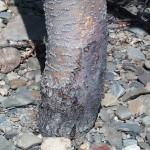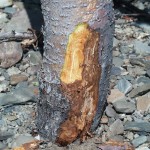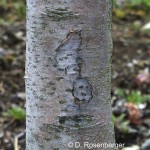Monday, 30 June 2014:
In case you missed them, I recently published two articles in Scaffolds Fruit Journal that I will not duplicate here. The article last week (23 June) was titled “Controlling Summer Diseases on Apples” and focused on spray timing and fungicide selection for controlling sooty blotch and flyspeck. The article published today was titled “Controlling Summer Diseases on Apples — Part II: Bitter Rot” and describes my contention that maintaining adequate soil moisture during heat waves may be critical for controlling bitter rot on highly susceptible cultivars such as ‘Honeycrisp.’
Brad Majek, weed scientist in New Jersey, recently published a warning about potential phytotoxicity to tree fruits from glufosinate herbicide (Rely and generics). His short article appeared in the Rutgers Cooperative Extension Plant and Pest Advisory. One of the photos in Brad’s article looks very similar to the damage that I continue to see in many Hudson Valley apple orchards.
I’ve suggested in the past that glyphosate (Round-up and generics) may be causing trunk damage in some orchards. I continue to believe that glyphosate can be especially damaging to some cultivars of apples (e.g., Macoun) when those cultivars are grown on light or gravelly soils. My hypotheses were published about 10 years ago (Scaffolds, June 14 2004*), but we have never been able to actually prove that glyphosate caused the basal trunk cankers that were described in the 2004 article. Nevertheless, I am aware than many growers who observed similar trunk damage in their own orchards have switched away from glyphosate to alternative herbicides, and some have undoubtedly switched to glufosinate. The article and photos by Majek suggest that switching from glyphosate to glufosinate may be somewhat akin to jumping from the frying pan into the fire.
It is very clear, after many years of orchard use, that NEITHER glyphosate nor glufosinate cause trunk injury to apple trees every time that they are used or in every orchard in which they are applied. Nevertheless, observational evidence suggests that both of these products can damage trees under some conditions. The exact conditions that contribute to damage have not been defined, but I continue to suspect that the potential for damage is significantly higher if tree trunks are hit with either of these herbicides during or just prior to periods of drought stress. The additional desiccation from herbicide exposure combined with normal water stress during hot dry periods may predispose the trunks to invasion by Botryosphaeria dothidea, a canker pathogen that is incapable killing the cambium in healthy functioning trees, but which becomes very pathogenic in drought-stressed trees. In some cases, I suspect that gramoxone can also contribute to similar trunk damage, especially on young trees.
Ultimately, the best way to avoid herbicide damage on apple trunks is to avoid hitting the tree trunks with the herbicide sprays. However, that is virtually impossible because avoiding the trunks would allow some weeds to persist around the trunks and in the line between adjacent trees. A more feasible approach may be to avoid application of herbicides during periods when trees are already experiencing water stress or where water-stress can be expected in the near future (e.g., ahead of heat waves where temperatures are predicted to exceed 90 °F). If water stress is mitigated via trickle irrigation, then I suspect that trunk injury from herbicides will also be less likely than in orchards where trickle irrigation has not been installed or where installed irrigation systems are not turned on soon enough.
Remember that in super-spindle orchards with trees planted 3 ft apart within the row and rows only 10-12 ft apart, the root zone for each tree is limited to roughly a 3-ft by 3-ft plot. Completion between trees will limit root growth along the row and soil compaction from tractor traffic in the narrow rows will limit root growth into the row middles. If natural rainfall in any given region would not provide enough water to reliably maintain a productive apple tree in a 3-ft by 3-ft container, then it hardly seems logical to expect high density plantings to perform well in the field without supplemental irrigation. As noted at the beginning of this post, irrigation may be important for controlling bitter rot on some cultivars in some regions. The probability that high-density plantings without irrigation will encounter more problems from herbicide-related trunk cankers provides another reason to consider irrigation, especially for plantings located on shallow, light, or gravelly soils that have limited water holding capacity. Ultimately, most modern high-density apple orchards are going to need trickle irrigation to optimize productivity and avoid disease problems.
*Note: Links to photos in the 2004 Scaffolds article are no longer functional, so the photos associated with that article have been inserted below.




